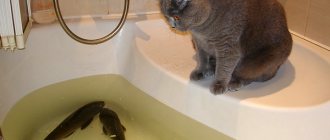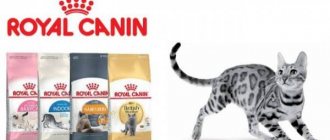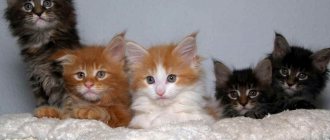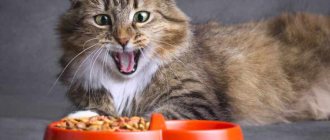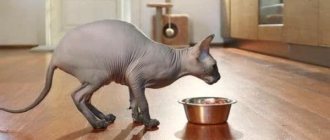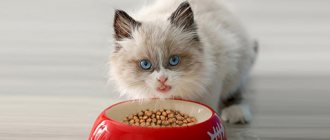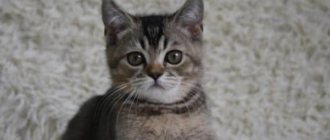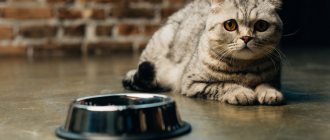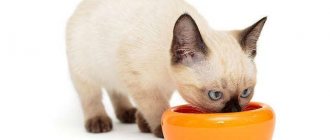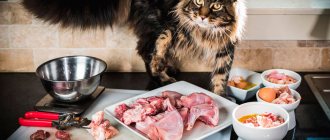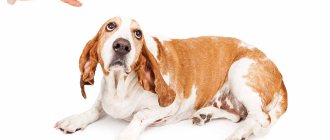- Cats
What to feed a kitten? It would seem like a simple question. Meat, milk, leftover soup and fried fish from the holiday dinner, or better yet, the popular Whiskas, which, according to the advertisement, has become even tastier.
Alas, in reality everything turns out to be not so simple. Many of the foods that we are used to giving our pets are harmful to them. As for cheap, but well-known foods, it is better not to buy them at all, unless you value the health of your tailed baby. There are some nuances in how many times to feed a kitten, and many other tricks that affect the healthy growth of the animal.
Kitten feeding regimen
To begin with, it is important to understand when to introduce complementary foods and how often to feed the kitten. You, of course, can be guided by the kitten's hungry look, but it is better not to awaken the beast in him, and 3-4 weeks after birth, begin to gradually feed the baby.
By 4 weeks of age, a stable eating schedule should be established.
The baby should receive additional feeding 4-7 times a day.
But there are stalemate situations when kittens need additional feeding much more often.
How many times a day should you feed your kitten?
- age up to 2 weeks – 10 times a day (with night coverage);
- feeding a one-month-old kitten – 8 times a day (including the night);
- 1 - 2 months - 7 times a day (night is already excluded);
- 2 - 3 months - 6 times a day;
- 4 months - 5 months - 5 times a day;
- 5 - 9 months - 4 times a day;
- 9 - 12 months - 3 times a day;
- Feeding kittens from 1 year of age becomes twice a day (for example, 9:00 – 21:00).
How much food to give a kitten:
- Age 1 week – 30 ml per 100 g of kitten weight;
- 2 weeks – 38 ml per 100 g of kitten’s weight;
- 3 weeks – 48 ml per 100 g of kitten’s weight;
- 4 weeks and subsequent – 48-53 ml per 100 grams of kitten weight.
How much should a kitten receive per day?
Of course, it’s easy to calculate the amount of feed based on the items already proposed, but we’ll make the task easier and give a few numbers:
- At 1.5 months, a baby needs about 120 grams of food per day;
- We feed a two-month-old kitten more - 160-180 grams per day;
- During the period of active growth (3 months - 6 months), the daily food intake is 180-240 grams, with at least 40 grams of meat;
- A six-month-old baby needs up to 180 grams of food per day;
- At 10-12 months, the period when the kitten’s activity decreases, the daily food intake is 150-200 grams.
It is important to give vitamins to your pet.
Feeding kittens from 0 to 6 months Childbirth, although natural, is an absolutely unpredictable process. Complications associated with labor often lead the mother to the operating table or force her to undergo drug treatment. It doesn’t matter for what reasons kittens are left without mother’s milk, it is important to know what to do next and how to properly feed the kitten with a pipette.
- Chinchilla
- Dog breeds
- Urban dog breeds
- Origin of the cat
- Hypoallergenic dogs
- Fighting dog breeds
If the birth is planned, buy a bag of cat milk replacer; if you don’t need it for kittens, give it to mom, she won’t mind the extra vitamins and protein. During the “season” for the birth of stray kittens, abandoned newborn babies are often found. When you find a find, act quickly - ask, buy, but find food for the kittens!
Cat's milk consists of 50% protein, and its complete analogues do not exist. Suitable for feeding are cat milk substitutes (sold in pet stores), infant formula without additives and sugar, natural condensed milk without sugar (prepared at home), products for newborns from the “dairy kitchen”, goat milk, in extreme cases - homemade cow milk.
You will need a pipette, an insulin syringe with a soft plunger, or a special nipple for feeding. A well-washed and boiled tube of naphthysin or other drops and a rubber band from a pipette as a pacifier will be suitable for available means. Make sure that the elastic band is held very tightly and is made of medical latex!
If a kitten has swallowed a piece of latex, drop 1-2 drops of Vaseline oil into the animal’s mouth every 2 hours. Fat envelops the disintegrating latex and removes it from the body.
If you decide to syringe feed your kittens, practice; the milk should be squeezed out drop by drop. A kitten’s protective reflexes are weaker than those of adult animals; a choked baby is almost impossible to resuscitate.
It is advisable to feed the kittens in a natural position - the animal lies on its stomach, rests its hind legs on the floor, and tramples the side with its front legs. One option is a cat litter box with a low side, covered with several layers of fabric or a thick towel.
For the first 3 days, kittens eat every 2 hours, day and night. After surviving 3 days, switch the kittens to food once every 4 hours.
The milk must be warm! 30–39 C° in the first 3 days, not lower than 30 C° in subsequent days.
Feed the kitten until he stops sucking; most often, after eating, kittens immediately fall asleep. At your discretion, before or after feeding, gently massage the tummy and area under the tail with a damp, warm cloth or cotton swab until the baby defecates. This stage is extremely important; kittens cannot empty their intestines and bladder without stimulation - licking or its imitation. After defecation, the kitten needs to be fed.
Kittens should be in a warm nest (temperature no lower than 25 C°) with dim lighting until their eyes are fully open; kittens do not tolerate bright light.
For full development, kittens need to crawl and be in contact with their mother. Place a heating pad wrapped in wool in the nest, using a stuffed toy as a “reservoir” for the heating pad.
Increasing and decreasing dosage
How much dry food should be given to cats also depends on changing quantities that can be missed.
Physical activity
A pet can eat more abundantly if it does not lie on the couch in front of the TV for days on end: it can frolic in the room, it is played with and trained. Homebodies are in the same microclimate all year round, but for those who regularly walk and, say, live in a house with a yard, supplementation is essential in the cold season. In nature, natural hunters rest less, are constantly moving and will not be able to recover without training.
Age
A growing fidget does not save energy. Starting from three to four months, adolescents absorb the same amount of food as adults. When a family friend reaches seven years of age, adjustments are made and the edible quota is reduced.
Homeostasis after castration or sterilization
Losing the characteristic level of testosterone, males are prone to urolithiasis. Such individuals buy foods with a rich content of polysaccharides and legnin and reduced fat content. To prevent turning into an obese lazy person, the cat is given special attention: they play for a long time and are taken for a walk.
Pregnancy and lactation
In the second week of gestation, females increase the norm by 15%, and in the third - up to 50. The type of food remains the same, but with the addition:
- calcium;
- vitamins A, E and K;
- fiber.
The issue is resolved by switching to a specialized version from a familiar manufacturer. Well-known companies have a variety of product lines in their assortment and finding the right one is not difficult.
Before giving birth, animals usually refuse to eat. This is a natural and harmless reaction - there is no need to force it.
External factors
The diet is recommended for those who are injured, sick or under stress. They are given delicate, easily digestible food. When choosing a table in such cases, they try to purchase a gentle, lean substitute. The approach is also recommended when the person is overtired, after a long transportation or a powerful load on the musculoskeletal system.
Food basket for kittens
Let's look at the cat's “food basket” - what you can feed kittens from homemade food, that is, “natural food”. The first thing is meat, namely beef. A bird would also work. It is better to avoid pork; a kitten can easily overeat it out of habit; on top of everything else, it is a source of helminthiasis infection. If we talk about fish, there is nothing better than sea fish. You can get a lot of things from river fish. But even sea fish should be given infrequently - a couple of times a week is more than enough. For young creatures, the meat must be boiled, but older pets can eat it raw, but only in moderation.
What better way to feed a kitten than with milk; there is simply no dearer food for it. However, not every cat will drink cow's milk. In some animals, the stomach simply cannot tolerate it. In such cases, the baby can be given yogurt or other fermented milk product. The main thing is that its fat content is not too high. Another good product for a growing animal is cottage cheese. Small pets are given cottage cheese puree with yolk, milk, or all together. Few people will refuse such “mogol-mogol” and usually the kitten devolves it with great pleasure. You can also pamper your pet with rennet cheese and sour cream.
In order for an animal to develop fully, it requires fiber contained in products of plant origin - these are vegetables and cereals. To compensate for this need, the kitten needs to cook porridge. For the smallest kittens, on a milk basis, and for older animals on meat, chicken, and fish broths. Only legumes should be avoided, since it has already been mentioned that feeding legumes leads to bloating and constipation, and they are also poorly absorbed by the body. Meat and vegetables are added to porridges made with meat broths.
Don't forget that your baby should have 24/7 access to fresh water. This aspect is especially important when feeding dry food. After all, cats that consume store-bought food drink almost four times more water than animals that eat natural products. Change the water regularly, and wash the container underneath and scald it with hot water.
Which food is better for kittens - dry or wet?
The opinions of different experts regarding the issue of artificial food do not agree: there are many pros and cons of such a diet. Each owner makes his own decision regarding the diet of his beloved pet and, if you prefer special canned food or dry pads, you must choose what food to feed the kitten. There is no significant difference between the two types of cat food, however, there are more cases of animal poisoning among those who eat canned food.
When choosing, you should take into account the age and breed of the animal. Many food manufacturers provide the addition of various substances for hair growth, which is important for British and Scottish folds, but completely useless for sphinxes. Feeding a kitten canned food for adult cats is fraught with indigestion and other side effects, so it is important to pay attention to the recommended age indicated on the package.
Advantages
Each feeding option usually has its pros and cons. It’s probably worth starting with the main advantages of this type of nutrition:
- The opportunity for the owner to select products for preparing food for kittens, focusing on their freshness and quality. This allows you to have more confidence that the prepared food is healthy for the baby.
- The food that is intended for the animal is always fresh, there are no chemicals in it, and therefore it will not only be useful for the still weak body, but also safe.
- The pet receives a variety of food daily.
- This food does not contribute to the development of addiction, the kitten will not suffer from painful addiction. Some foods can be freely replaced with others without causing stress to the kitten.
Flaws
As for the negative aspects of natural feeding of an animal, the following main points should be highlighted:
- It is necessary to carefully monitor that the diet does not contain foods that are undesirable, or even dangerous, for the kitten’s digestive system.
- Ordinary food does not always contain enough vitamins necessary for the normal development of a kitten at two months of age. To balance the diet, you will have to buy them specially and, after calculating the dose yourself, add them to your cat’s dishes.
But regardless of the option you choose to feed your pet, protein should be the basis of nutrition. Only they participate in the construction of a living organism. Therefore, the diet should consist of foods that are rich in protein, in a proportion of approximately more than half of the daily diet. Fish and meat products have a sufficient amount of protein.
But not only protein foods should be included in the baby’s diet. It is necessary to ensure that it contains various vitamins and microelements in sufficient quantities. The kitten's body is growing and it needs to have plenty of calcium, which promotes tooth growth and skeletal development. These substances are found in whole milk and fermented milk products. Knowing what a kitten should eat for 2 months and what should be removed from its diet, the baby’s owner will be able to confidently create a high-quality diet that will include necessary and healthy natural products.
Of what
There is no need to invent any devices to feed kittens. It is necessary to use dishes designed specifically for animals, as they will be much more convenient.
Bowls
The bowl for feeding a kitten should not be deep and wide enough for the baby to eat comfortably. It is best to choose dishes made of metal and ceramics, since plastic bowls can accumulate harmful bacteria and can also cause allergies. Ceramics are the most expensive, but also high-quality option.
It is not worth purchasing combined dishes for water and food. The fact is that due to the proximity of food, the water will regularly get dirty, and cats at any age only need it clean. The color of the dishes should not be very bright, which can scare away the baby, since in nature, bright colors often indicate the toxicity of an animal or plant. The reaction to them is inherent in animals at the genetic level.
Consequences of poor nutrition
Poor nutrition, especially during the growth period, is the cause of many diseases and disorders:
- Stunted growth;
- Incorrect formation of the skeleton;
- Metabolic disorders;
- Reduced immunity;
- Allergic reactions;
- Poisoning;
- Worm infestations;
- Reproductive dysfunction.
Without following the basic rules and norms of feeding, it is impossible to raise a healthy animal that meets all the characteristics of the breed.
Natural nutrition
Those who adhere to the position of feeding kittens with natural food are confident that only such food is safe and healthy for them. Naturally, for them there is no question of what to feed the baby at this age, since they have already made their choice. However, it is worth noting that natural foods that are considered acceptable for kittens are not at all the same products that humans consume. This is a specially produced food that contains useful substances and no chemical additives.
Veterinarian advice
For cats living in apartments, their daily routine is very important. The sooner a kitten gets used to receiving food at a certain time, the faster its digestive system will adapt to an adult diet. This is due to the fact that digestive enzymes will reach their maximum concentration strictly at the hour of feeding, which will have a positive effect on the absorption of food.
The place in which the pet is fed is chosen to be quiet and calm, where the kitten will not be in the aisle and will not be disturbed. Without this, against the backdrop of constant stress while eating, your pet may develop digestive problems, which will negatively affect its development and growth.
When there are several kittens in the house, their food bowls are placed in different places. This avoids competition for food that is unacceptable. If the kittens compete, then the weaker pets will remain hungry, and the stronger ones will begin to overeat. As a result, everyone's health will be harmed.
Nibelung cat breed, character and description
The kitten should only be given food at room temperature. Do not give hot food. It is unacceptable to expect that the baby will wait until it cools down. In most cases, the kitten will get burned and become afraid of the bowl, which will significantly complicate the feeding process. If the burn is severe, then treatment will also be required.
Ready-made food for kittens
Today, there are a lot of ready-made food for kittens. Whether to give such food to a pet is a personal matter for the owner.
If you decide to introduce ready-made food into your kitten’s diet, you should remember the following rules:
- Under no circumstances should you give your pet food from different manufacturers. You should choose one, the most optimal food for regular feeding of the kitten.
- You cannot feed your pet the cheapest food.
- From time to time, in addition to food, the kitten needs to be given natural food.
- A kitten that eats food must drink a lot. The water must be filtered and located in such a place that the pet can reach it at any time.
- When choosing food for a kitten, you must be sure to familiarize yourself with its composition. If the composition is questionable, choose another food.
A kitten's nutrition is the key to the animal's health. Don’t forget that your pet’s immunity is formed at an early age. Therefore, the kitten’s diet should include fresh and vitamin-rich foods.
Proper feeding of a suckling kitten
Now about how to feed a newborn kitten from a technical point of view. If the kitten sucks the formula from the bottle incorrectly, it does not eat enough, swallows air, etc. This leads to additional sleepless nights and anxiety.
Something else interesting :
- Protein sources for cats – eggs
- It is best to hold the kitten on your lap or with a warm towel in your palm. How to hold the bottle will be described in detail in the instructions for the mixture. But in general, the kitten should be positioned at an angle of 45 degrees to the horizontal and tightly grasp the nipple. Avoid breaking the latex nipple and avoiding excessive tilting of the bottle. The entire nipple should be filled with liquid to prevent the kitten from swallowing.
- You will have to bottle feed your baby for at least 2 weeks from birth; you cannot add anything during this time. If you have any problems, contact your doctor immediately and do not self-medicate. Such small kittens are not dewormed until they are stronger. It is also forbidden to poison a kitten with fleas. The maximum that can be done for a healthy newborn kitten is to drive fleas off the litter.
When he doesn't eat on his own
If the kitten is still very small and cannot eat from a bowl on its own, then you should purchase a special bottle for feeding it. When there is none, you can use a pipette, a syringe or a piece of bandage twisted into a tourniquet. The message option is considered the worst, since there is a risk that the baby will swallow the thread, and this is dangerous.
Advice! Before the 5th day, kittens should be fed once every 2 hours around the clock, and from the 5th day - once every 3 hours and also around the clock. In the period from 2 to 3 weeks, only one feeding is needed at night, and during the day food is given once every 3 hours.
A small kitten is fed from a bottle
A special bottle with a nipple for feeding kittens, which can be purchased at a pet store or veterinary pharmacy, is the optimal solution. It is made in such a way that when sucking the baby will not swallow excess air, and the size of the nipple is optimal for the kitten’s mouth.
If feeding is carried out using a pipette and a syringe, then the rubber part of the pipette is pulled onto the nose of the syringe instead of the nipple. The baby will suck on it. It is unacceptable to pour in milk by force, since in this case, most likely, the baby will suffocate and choke.
When, as a last resort, a bandage is used, it is folded so as to minimize the risk of threads getting into the mouth. The resulting flagellum is dipped in milk and given to the pet to suck.
Solid food feeding
As soon as the kitten has its first sharp teeth, you can gradually give it other foods other than milk. There are no unusual products in this complementary food. It is very important that the animal's food is warm. You can feed him well-cooked oatmeal with the addition of hard-boiled egg yolk. Cottage cheese diluted with warm milk, it is advisable to grind it with a teaspoon until it becomes mushy. Ground beef, pour boiling water over it, or freeze it in the refrigerator for 2 days to kill some harmful bacteria.
How to tell if a cat is eating
It is not difficult to understand that a cat has already eaten. A well-fed animal simply will not eat anymore. The exception is when the pet is prone to overeating. Therefore, the cat’s diet must be controlled.
If the animal does not noticeably lose weight, behaves actively and looks good, then its nutrition is balanced. In case of noticeable weight loss, the diet should be reconsidered. In this case, the animal may not eat enough.
A hungry cat will also act restless. Run after the owner, meow.
Further complementary feeding
So, time flies very quickly, and in a couple of months the kitten turned from a little fool into a charming playful creature. Now he needs more and more strength and energy, so his nutrition should be different, and a new product should be introduced weekly. They try to give boiled lean chicken, rabbit or turkey; low-fat sour cream, boiled beef liver, boiled fish or poached for a minute, separated from the bones. Boiled and chopped chicken or quail egg. Pumpkin puree with milk.
Any unfamiliar food should be given to a kitten in small doses and its behavior and well-being should be carefully observed. If the influence of a new bait negatively affects him, it is best to exclude him from the diet.
Animal weight measurements
It is necessary to constantly weigh cats, especially kittens, to understand the correctness and completeness of their diet. Females often weigh less than males, and the weight of the animal depends very much on the breed. For example, in a year the British weigh from 4.5 to 7 kg, Maine Coons at the same age gain weight from 5.9 to 9 kg.
It is important to control your cat's weight from birth
However, the standard weight for most breeds of domestic cats is from 2.5 to 4.5 kilograms. If your cat's indicators go beyond these limits, you need to look for a different approach to feeding her. You may need to change food, increase or decrease the number of meals, and so on. Every animal, like every person, is unique. Therefore, the diet for him must be selected individually.
Age 3-6 months
At this point, the kitten's teeth and jaws are fully formed. Therefore, you can forget about the grater. But you'll have to pick up a knife. Because pieces that are too large will only be slobbered on and thoroughly chewed, but they will never get into the kitten’s stomach.
But now you don’t have to necessarily cook the meat and vegetable components of the menu. Of course, you will still have to cook the porridge, because kittens do not eat raw cereals. Raw fish is added to the diet. Strictly sea and boneless. River fish is contraindicated!
The milk is completely removed. It is replaced with low-fat cottage cheese or fermented milk products. You can sometimes give egg whites, raw ones. But teenage kittens often become indifferent to eggs in general. But at this time, unexpected taste habits are formed. Therefore, it is very important now to diversify your pet’s menu as much as possible. Otherwise, he will get used to one product and simply ignore the rest.
By the way, there are many known cases when kittens after 3 months demanded completely non-cat products:
- corn
- honey
- chocolate
- raw potatoes
- sunflower seeds
- fresh cucumbers
- dried fruits
Every normal person understands that such nutrition does not contribute to the full development and good growth of a kitten. Some make excuses by feeding the fluffy another candy: “Well, he loves it! »
You never know who loves it! But cats also have diabetes, obesity, urolithiasis and other human diseases. And they do not arise on their own. Domestic cats are fed by humans, which means that it is he who is to blame for the pet’s illness.
Do you want to pamper your kitten? Give him a prohibited non-cat product. But very little and very rarely. Let it remain a delicacy or a reward, but not a permanent menu item.
What should you not feed your kitten?
Everyone knows that chips and cola are harmful to a child's health. He should not be given these products, as they have a detrimental effect on the body. The same goes for baby cats; their bodies also cannot process some foods. To keep your kitten healthy and active, exclude the following foods from its diet:
- The liver is useful only for humans, but for cats it does not have much benefit. If you give it to a kitten, then in vain - it is an empty product for him.
- Even if you feed your baby dry food (moistened in water), it is still necessary to add variety. For example, you can give meat and dairy products.
- River fish, even boiled ones, are carriers of all kinds of parasites. It should not be given to a kitten.
- Sausage, smoked meat, lard, fish and other similar products are food only for people. It contains a lot of fat, salt, seasonings and other components harmful to the body. By the way, this applies not only to cat health.
- Sweets are for children, not kittens. They ruin teeth, and in general, sugar is harmful to animals.
- Dog food! Never give one, even if the cat's supply is over. Go to the store and buy it. As a last resort, give natural food.
- Bread and other flour products.
Recipe for an inexpensive and tasty dish for a kitten
If the owner has a limited budget and time, then he needs to prepare food for the kitten in advance, which he can eat for several days in a row.
To do this, you need to finely rub 1 kg of beef through a sieve and add two chopped carrots to it. This mass must be supplemented with 200 grams of the simplest cheese, 2 yolks and a tablespoon of brewer's yeast. If desired, you can add a few drops of vitamins for animals.
This mixture should be carefully moved, rolled out with a rolling pin and placed in the freezer. Next, you need to boil the homemade food in small pieces
and feed the kitten. This product is used as the main food as it contains everything that is necessary for the full development of a young kitten.
When choosing any food, you need to pay attention to the condition of the animal.
. The kitten should always be in a good mood. It is imperative that he has smooth fur and strong claws.
You also need to observe whether your pet eats with appetite.
. After some time, the owner will independently understand what to feed the kitten. If your kitten is older than 3 months, you can switch to a balanced raw diet.
Recommendations from nutritionists:
- Don't feed your cat natural foods. When systematically combined, ready-made cat food and natural products will cause imbalance in nutrition - oversaturation of the body with some elements with a lack of others and, as a result, illness.
- Provide your cat with clean, fresh drinking water at all times. It is completely unacceptable to have a full bowl of dry food and an empty water bowl: the cat is at risk of dehydration.
- Canned cat food is more flavorful than dry cat food and comes in a wider variety of flavors.
- Heating canned cat food to a temperature of 39 – 40 °C can enhance its smell and indirectly improve its taste; this can be used when feeding a picky cat.
- Experts recommend not mixing dry and canned food - the effect of such a mixture is closer to dry food. It is better to feed your cat only canned food from time to time.
- Cats are very good at recognizing shapes and prefer food with small granules.
- It is not at all necessary to change food throughout the cat's life. You can choose a high-quality cat food from one brand and stick to it according to your cat's age and weight.
- Many diseases cause changes in taste in cats. In this case, you should use special dietary food for cats with the best taste (Hill's, Iams, Mars, Royal Canin).
And finally, you can determine how suitable the food you have chosen is for your cat using the following external indicators:
- Optimal fatness of the pet (ribs are not visible, but are easily palpated);
- Good physical condition;
- Shiny coat;
- Small volume of stool (approximately 25% of food eaten);
- Maintaining a constant weight of the cat.
Video
How many calories do you need per day
The total calorie content is calculated using the following formula: K*(30*m + 70), where K is the multiplier coefficient, and m is the body weight of the animal. And if everything is clear with indicator 2, then the required coefficient value can be found in the table below.
| Physiological features | K |
| Obesity diagnosed by a veterinarian | 0,8 |
| Tendency to overeat, fraught with rapid obesity | 1 |
| Elderly age | 1,1 |
| Spayed and neutered animals | 1,2 |
| Kitten or adult pets with a small body weight | 1,2-1,4 |
| Inactive adult cat | 1,4 |
| Active adult cat | 1,6 |
| Gestation period for kittens | 1,6-2 |
| Breastfeeding period | 2-4 |
If your pet weighs 5.5 kg, constantly begs and eats everything that is not nailed down, and his furry body can hardly fit into his own house, then he will need 235 kcal per day. Please note that this is not a single portion, but a daily one. It will need to be divided by the number of feedings (usually 2).
Another example is the chicken-flavored Eukanuba. The calorie content of the granules is 4000 kcal per 1 kg, and the weight of the pack is 2 kg. That is, our hypothetical cat will have enough of this pack for 34 days (4000 kcal * 2 kg/235 kcal).
The required number of grams can be found by dividing 2 kg by 34 meals received previously. When rounded, the result is 59 g, and this figure actually fits into the standards specified by the manufacturer.
